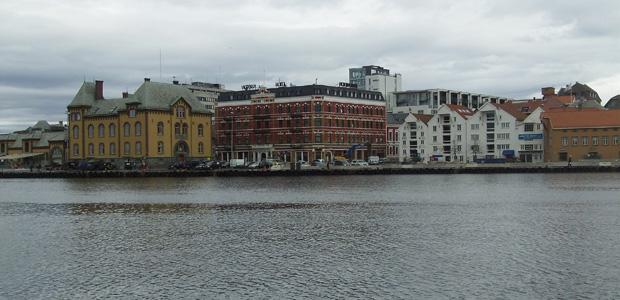Norway’s Example of Oil and Gas Boom Done Right
Stavanger has grown wealthy on the proceeds of the oil industry and is now one of the most expensive cities in the world. (Photo: Laura Lynch)
In the pretty harbor city of Stavanger, on Norway’s North sea coast, the seagulls are screeching high above the town square adjacent to a sparkling blue fjord. Here, it’s easy to get a glimpse of the country’s hardscrabble economic past and its booming present day spectacular wealth.
This harbor used to be lined with herring canneries, dozens of them. Piers Croker, the curator of the Norway Canning Museum, says it was the lifeblood of Stavanger.
“Let’s put it like this,” he says. “Fifty percent of the working population was employed in the canneries; another 15 percent in the supply industries. And there was a newspaper headline in the 1920s ‘The City that Stands on One Leg’ and that leg was canning.”
Croker shows an old canning machine and says one employee set a record when he managed to seal a thousand cans a day. That man’s grandson still lives in the town. But the canneries were all gone by the early 1980s.
Almost everyone now works in the offshore oil industry that transformed the town. Croker says the change was stunning.
“There was a guy who had been in the in canning industry for 30 years. And his wages, when he retired from the canning industry, were less than his 18-year-old daughter [was making] beginning in the oil industry.”
The sleepy fishing town now boasts high-end fashion shops. The harbor is dotted with cranes and offshore oil platforms either in for maintenance or ready to float out to the North Sea drilling sites. It is evidence of good times. But it is also proof that Norway has avoided the so-called “Dutch disease.” Everywhere else in the world a boom in oil has led to a decline and sometimes devastation of other parts of the economy.
Norway’s success, some say, is largely down to one man. “Had [I not come] to Norway, I probably would have not done even anything with these ideas,” says Farouk al-Kasim. Al-Kasim, who is in his mid-seventies now, moved to the town with his Norwegian wife and family in the late 1960s from Iraq where he worked as a geologist for the state oil company.
Al-Kasim quickly found work just as one of the world’s largest oilfields was discovered off the coast of Norway. The government saw his background and hired him to help devise a strategy for managing the resource and the revenue. Al-Kasim says one of the first things Norway did right was to control its new found wealth.
“You don’t really benefit at all by allowing oil revenue to come onto you like a tsunami and flood everything that will completely destroy non-oil sectors of the economy,” he says. That’s what happened in the Netherlands in the 1970s. As oil exports boomed, the flood of money into the domestic economy inflated the currency, leading to price increases. The increases destroyed exports and led to joblessness and inequality.
By contrast, Norway has held on to almost all of the revenue it earns in a giant and ever-growing savings account, known as the “oil fund.” It now holds almost $600 billion and is one of the largest sovereign wealth funds in the world.
Petter Osmundsen, professor of petroleum economics at the University of Stavanger, says the small amount the government withdraws for spending each year – four percent – is more than enough. “We have been spending a lot of money so even this four percent is a very good increase in public budgets over the last years with good oil price and high oil production,” he says. “We are not starving.”
And the sovereign fund isn’t allowed to invest in Norway. That helps avoid inflation and makes non-oil companies more competitive globally.
But there are challenges. Osmundsen says the global financial crisis has made Norway almost too successful compared to its neighbors.
“We are having good times whereas the others are having bad times,” Osmundsen says. “So we keep getting pay rises whereas the other countries are getting pay cuts. If this lasts for a number of years the Norwegian competitiveness will be reduced in other industries than oil.” So earlier this month, Norway decided to cut its spending from oil income by a billion dollars to slow economic growth.
None of this seems to bother Norwegians, even though the fund holds more than one $100,000 for each citizen. They seem content to save for the future and continue to pay high taxes. Al-Kasim isn’t surprised by their attitude. He believes one of the reasons the Norwegian approach has worked is something he noticed when he first arrived more than 40 years ago.
Al-Kasim believes it was a legacy of the Second World War when Norwegians lived under Nazi occupation. “This sense of belonging together, being completely not only dependent on each other, but trusting each other, this solidarity in the nation was absolutely unique,” he says.
Across town from the simple structure that houses the canning museum, Stavanger’s oil museum is a much more modern, sleek building right on the waterfront. The almost spooky echo of a simulated depth sounder is one of the exhibits, along with scale models of drilling platforms meant to give an impression of what it’s like to drill for oil under the sea. But there’s also a digital clock showing the oil revenue climbing second by second. Another wing houses a gourmet restaurant with gourmet prices. Oil has been good to the town — it’s now one of the most expensive cities in the world. And to Norway.
